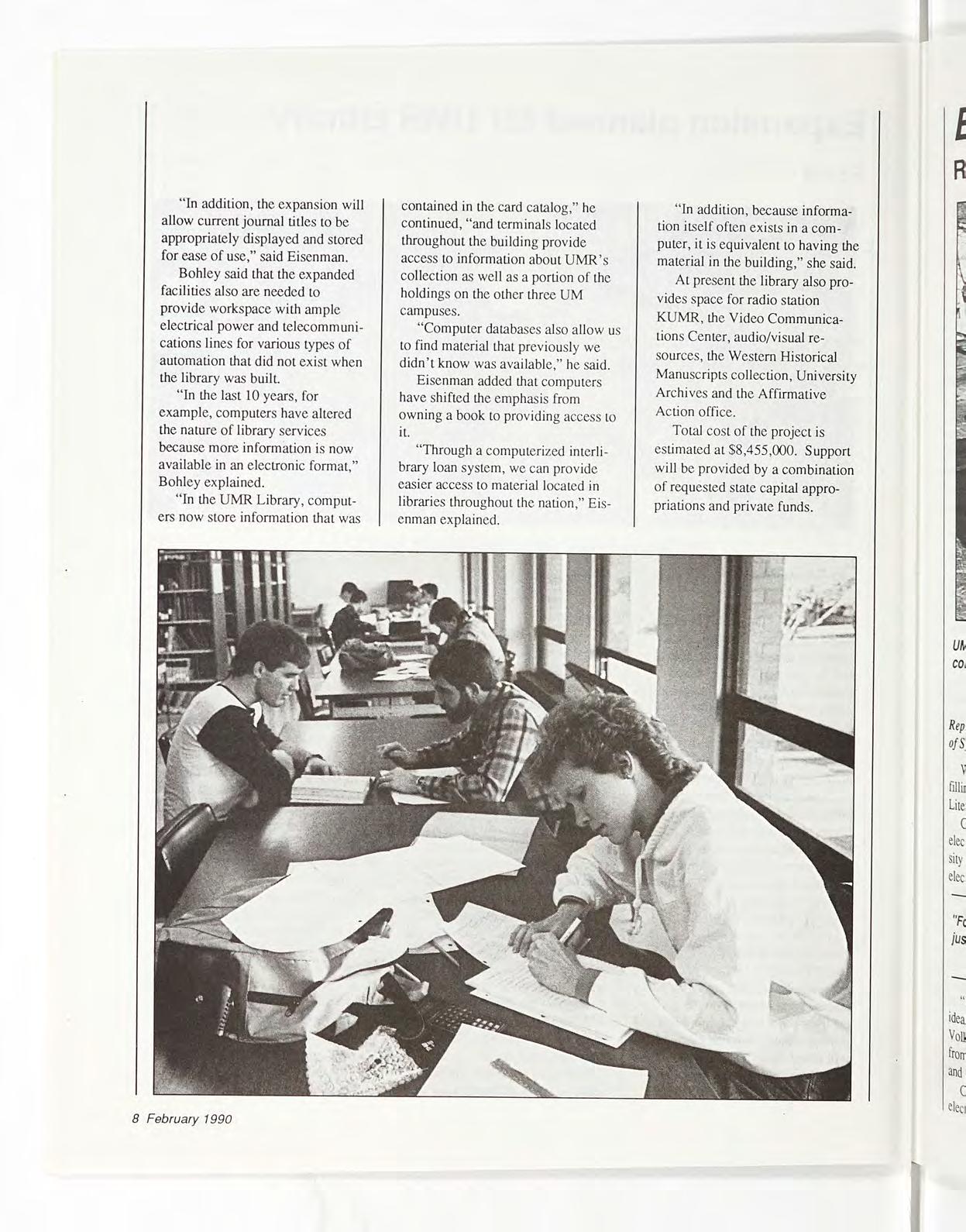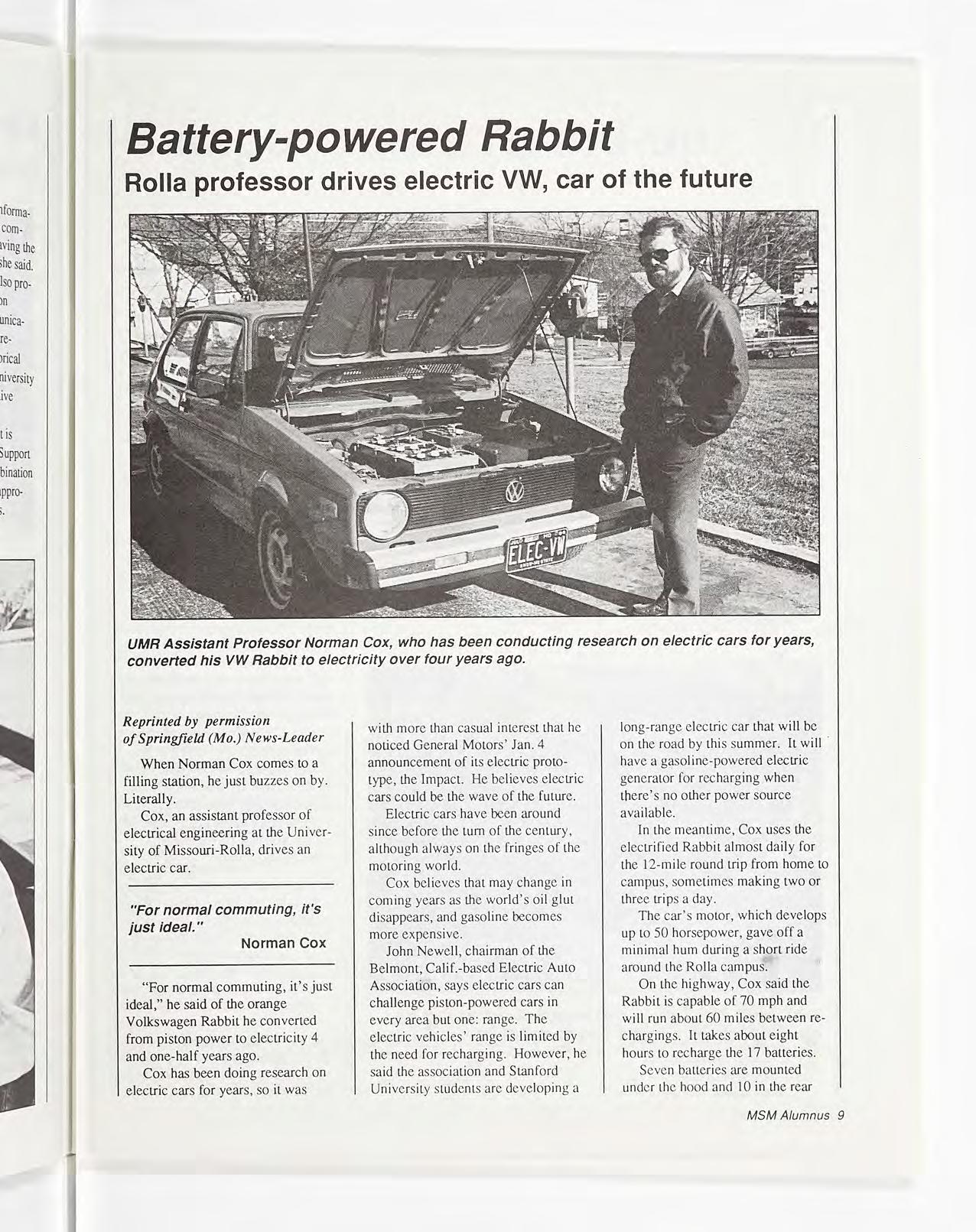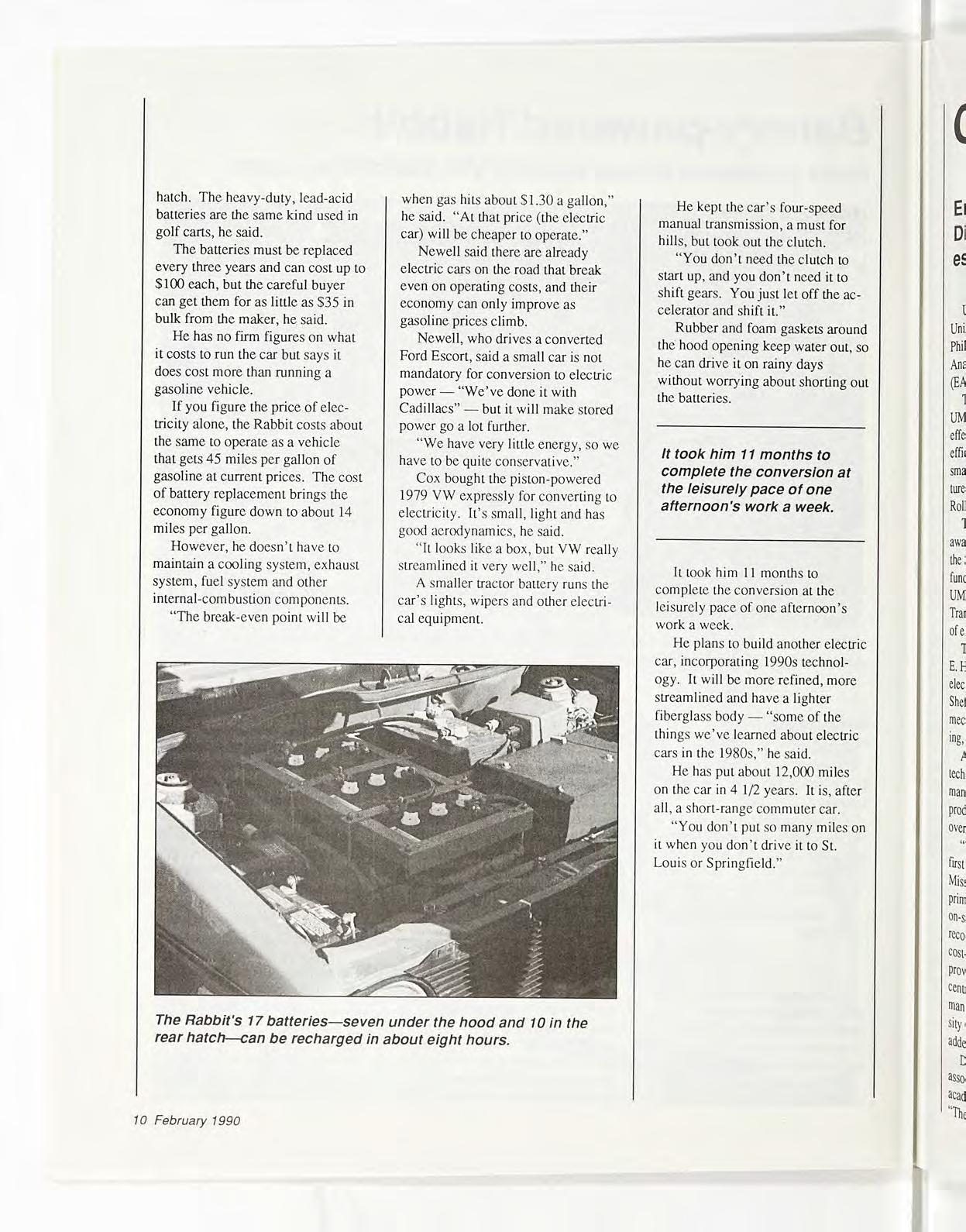
8 minute read
Expansion planned for UMR
from Missouri S&T Magazine, February 1990
by Missouri S&T Library and Learning Resources | Curtis Laws Wilson Library
Expansion planned for UMR Library
By Minnie Breuer
UMR 's Curtis Laws Wilson Library is a vital learning resource center for students, faculty, staff and the general public. Plans to expand the library's facilities would provide additional study , shelving and work space and allow for continued growth ensuring that the library will continue to be a high-quality learning resource. "The planned expansion will provide much-needed space for the library 's patrons, staff and resources and accommodate the projected increase in materials and services during the next 20 years, as well," according to UMR Chancellor Martin C. Jischke.
Dr. John Park, UMR vice chancellor for academic affairs, said, "The UMR Library, which is the primary resource center for teaching and research on the campus, has a well-qualified and productive staff and this expansion will allow them to continue to provide support for teaching and research activities in an efficient manner."
At its December meeti ng, the University of Missouri System Board of Curators approved the employment of Murphy, Downey, Wofford and Richman , Architects of St. Loui s to begin preliminary plans for an approximately 60,000-square- foot addition to the building.
The expansion will provide additional study space for about 600 persons, increased shelving space for the library' s holdings and appropriate display areas for current journal titles, according to Ronald Bohley, director of library and learning resources at UMR. "The present facility was built in 1968 to hold 300,000 volumes and to offer seating for 1,050 readers and work space for 18 fu ll -time employees," explained Bohley.
At thi s time, the library ho uses 420,000 volumes, provides study space for about 650 readers and employs a staff of 25. "Through the years, the amount of space used for study and work areas
has been reduced in order to make room for the increase In the library 's holdings," said Bohley. "Currently, each study station occ upies about 13 square feet," he added. "Guidelines prepared by the American College and Research Libraries recommend 25 to 35 square feet per study station."
According to Jean Eisenman, assistant director of public services at the UMR Library , an increase in the amount of shelving space will ease the crowding of the existing collection and also would accommodate the increase that is anticipated during the next 20 years. " During the las t decade, the library has added an average of about 10,000 volumes each year," Eisenman said. "If another 200,000 volumes are added to the collection in the nex t two decades, the library's collection could exceed 600,000 volumes, or twice the number of volumes the present facility was built to conta in ," she explained.
MSM Alumnus 7
" In addition, the expansion will allow currentjoumal titles to be appropriately displayed and stored for ease of use," said Eisenman.
Bohley said that the expanded facilities also are needed to provide workspace with ample electrical power and telecommunications lines for various types of automation that did not exist when the library was built. " In the last 10 years , for example, computers have altered the nature of library services because more inform ation is now available in an electronic format, " Bohleyexplained. " In the UMR Library, computers now store in formation that was contained in the card catalog ," he continued , "and terminals located throughout the building provide access to information about UMR's collection as well as a portion of the holdings on the other three UM campuses. "Computer databases also a llow us to find material that prev iously we didn't know was ava ilable," he said.
Eisenman added that compu ters have shifted the emphas is from owning a book to providing access to it. "Through a computeri zed interli brary loan system, we can provide easier access to material located in libraries throughout the nation," Eisenman explained.

" In addition , because information itself often ex ists in a computer, it is equivalent to having the material in the building," she said.
At present the library also provides space for radio station KUMR, the Video Communications Center, audio/visual resources, the Western Hi storical Manuscripts collection, University Archives and the Affirmative Action office.
Total cost of the project is estimated at $8,455 ,000. Support will be provided by a combination of requested state capital appropriations and private fund s.
8 February 1990
Battery-powered Rabbit Rolla professor drives electric VW, car of the future
UMR Assistant Professor Norman Cox, who has been conducting research on electric cars for years, converted his VW Rabbit to electricity over four years ago.

Reprinted by permission of Springfield (Mo.) News-Leader
When Norman Cox comes to a filling station, he just buzzes on by. Literally.
Cox, an assistant professor of electrical engineering at the University of Missouri-Rolla, drives an electric car.
"For normal commuting, it's just ideal," he said of the orange Volkswagen Rabbit he converted from piston power to electrici ty 4 and one-half years ago.
Cox has been doing research on electric cars for years, so it was with more th an casual interes t that he noticed General Motors' Jan. 4 announcement of its electric prototype, the Impact. He believes elec tric cars could be the wave of the future.
Electric cars have been around since before the tum of the century, althoug h always on the frin ges of the motoring world.
Cox believes that may change in coming years as th e world 's oil glut disappears, and gasoline becomes more ex pensive.
John Newell, chairman of the Belmont, Cali f. -based Electric Auto A ssociation, says electric cars can challenge piston-powered cars in every area but one: range. The electric vehicles' ran ge is limited by the need for recharging. However, he said the association and Stanford Uni versity students are develop ing a long-range elec tric car that wi ll be on the road by thi s summer. It will . have a gasoline-powered electric generator for rec harging when there's no other power source ava ilabl e.
In the meantime, Cox uses the electrifi ed Rabbit almost daily for the 12-mile round trip from home to campus, sometim es making two or three tri ps a day.
The car's motor, which develops up to 50 horsepower, gave off a minim al hum during a short ride around the Rolla campus.
On the highway, Cox said the Rabbit is capable of 70 mph and will run about 60 miles between rechargings. It takes about eight hours to recharge the 17 batteries.
Seven batteries are mounted under the hood and lOin the rear
MSM Alumnus 9
hatch. The heavy-duty, lead-acid batteries are the same kind used in golf carts, he said.
The batteries must be replaced every three years and can cost up to $100 each, but the careful buyer can get them for as li ttle as $35 in bulk from the maker, he said.
He has no firm figures on what it costs to run the car but says it does cost more than running a gasoline vehicle.
If you figure the price of electricity alone, the Rabbit costs about the same to operate as a vehicle that gets 45 miles per gallon of gasoline at current prices. The cost of battery replacement brings the economy figure down to about 14 miles per gallon.
However, he doesn't have to maintain a cooling system, exhaust system, fuel system and other internal-combustion components. "The break-even point will be

when gas hits about $ 1.30 a ga llon," he said. " At that price (the electric car) will be cheaper to operate."
Newell said there are already electric cars on the road that break even on operating costs, and their economy can only improve as gasoline prices climb.
Newell, who drives a converted Ford Escort, said a small car is not mandatory fo r conversion to electric power "We've done it with Cad illacs" - but it wi ll make stored power go a lot further. "We have very little energy, so we have to be quite conservati ve."
Cox bought the pi ston-powered 1979 VW expressly fo r converting to electrici ty. It's small , light and has good aerodynamics, he said. " It looks like a box, but VW rea ll y streamlined it very well ," he said.
A sma ller tractor battery runs the car's lights, wipers and other electri cal equi pment.
He kept the car's four-speed manual transm ission, a must for hill s, but took out the clutch. "You don' t need the clutch to start up, and you don' t need it to shift gears. You just let off the accelerator and shift it. "
Rubber and foa m gaskets around the' hood opening keep water out, so he can drive it on rai ny days without worry ing about shorting out the batteries.
He plans to build another elec tric car, incorporating 1990s technology. It will be more refined, more streamlined and have a lighter fiberglass body - "some of the things we ' ve learned about electric cars in the 1980s," he said.
He has put about 12,000 miles on the car in 4 1/2 years. It is, after a ll , a short-range comm uter car. " You don ' t pu t so many miles on it when you don' t drive it to St. Louis or Springfield."
The Rabbit's 17 batteries-seven under the hood and 10 in the rear hatch--can be recharged in about eight hours.
10 February 1990





